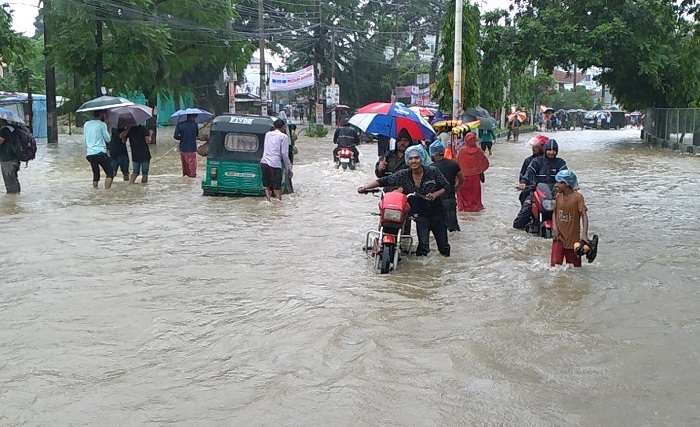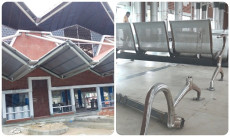
Kabir Ahmed Chowdhury
05 May, 2024 02:32
The flood is coming, please prepare!

Photo: Collected
After the intense heat, the country saw relief rain. While many other parts of the country are still experiencing intense heat, the situation in Sylhet region is somewhat different. It rains regularly here, the temperature conditions are also quite bearable. When the country is burning in the heat, there is a danger of flooding in the northeastern part of the country, especially in Sylhet.
The biggest damage caused by the flood is paddy, which the farmers have now started to take home. Paddy harvesting in many areas is at the end stage. Now it's time to dry the paddy and to shell it. They have started drying and storing not only paddy but also straw, as this straw is used as fodder for cattle.
Boro paddy meets at least 55 percent of the country's food demand. Cultivation of this boro is more in the 7 Haor districts of Sylhet, Moulvibazar, Habiganj, Sunamganj, Kishoreganj, Netrakona and Brahmanbaria. If this paddy is not damaged by heavy rains, floods and landslides in India, there is no shortage in the country's food demand. Therefore, favorable weather conditions, especially sunshine, are very important from the cultivation of this paddy to harvesting at home. Well, the final phase is nearing its end. But now the threat of flooding is looming.
The Flood Forecasting and Warning Center (FFWC) managed by the Bangladesh Water Development Board (BWDB) and the Directorate of Disaster Management said in a recent report that the water level in the rivers of the northeastern districts is increasing rapidly. It is creating risk of flash floods in several areas. The organization is closely monitoring the situation and has advised precautionary measures. The FFWC says pre-monsoon water flows may exceed the northeastern border districts including Sylhet, Moulvibazar, Sunamganj and Habiganj.
When the flash flood information is in the forecast, the information about the increase of water in the rivers of Sylhet region is matching. Meanwhile, two rivers of Sylhet have crossed the dry season threshold. According to the information of the Water Development Board, the water in Sylhet's rivers has increased due to rains in India for several days. The river crossed the dry season threshold at two points on Thursday itself. According to BWDB, the dry season danger limit at Kanighat point of Surma river is 10.80 meters. Danger limit in monsoon season is 13.75 meters. 11 at Kanighat point of Surma river from 9 am on Friday. 03 cm flowed over. Similarly, the Sarighat point of Jaintapur on the Sari River has a depth of 10.70 meters during the dry season. In the monsoon season, the danger limit is 12.35 meters. The water at that point in the river was standing at 11.87 meters, which is above the dry season threshold. Apart from this, the water is increasing at Sylhet point of Surma river and Sheola point of Kushiara river. But did not cross the threshold. However, if India's rainfall continues to descend, it may cross the danger line at other points.
As in 2017, the country's fields were not submerged in floods. Farmers were spoiled by the flood. However, the fear of flooding after harvesting the crops at home should be considered. The people of Sylhet region could not forget the terrible flood of 2022. In addition to the indescribable suffering, the loss of life, financial and infrastructure could not be recovered. Many parts of Sylhet still bear the scars of the floods two years ago.
About 70 percent of the district including Sylhet city was submerged in the 2022 flood. People have to suffer for a month due to long-term floods. After the flood, there was a demand to dig the Surma river. Although some work has been started, it has not been completed. In January 2023, 15 km excavation work started from Kusighat in Sylhet city to Dashagram in Vishwanath. The excavation work of this 15 km was not completed even in 15 months. But this project was supposed to be completed in four months. The project stakeholders are claiming that the excavation work is being hampered due to plastic and polythene waste. Excavation could not be completed on time. They claim that machinery and equipment break down due to plastic and polythene. They are also hopeful that they will be able to complete 80% of the work by next June, even if they cannot complete 100%.
After the last flood, there has been a lot of talk about the navigability of the Surma river, there have been demands to dig the river. Sylhet city is drowning not only during floods but also in light rains. The canals are narrow with encroachment and pollution, and many have become 'no'. As a result, little rain is causing flooding in the city. On top of that, there are various development works of the city corporation, which are creating obstacles in the normal flow of water. Little consideration has been given to water flow in dry season development activities, resulting in disruptions to normal water flow as summer projects are prolonged into the monsoon. And in the end, people are destined to suffer. There are also various developmental and infrastructures in the Haor area, which are allegedly obstructing the normal flow of the vast water bodies of the Haor.
A flood threat remains where we are now. The Flood Forecasting and Warning Center has warned about it. This warning was initially at the farmer level. The Department of Agricultural Extension had informed in a notification that harvesting should start only when the paddy is 80 percent mature. Farmers did just that.
After the regular work of the farmer, now the government-administration needs to prepare for dealing with floods. If there is less rain in India, there will be no floods in the country - instead of relying on nature, we need to focus on what processes can save people in case of floods.
There is time in hand, the right use of this time will be the work of time.







 সিলেট সিপিবি সাধারণ সম্পাদক সুমন ‘আটক’
সিলেট সিপিবি সাধারণ সম্পাদক সুমন ‘আটক’ 




 IT Lab Solutions Ltd.
IT Lab Solutions Ltd.
আপনার মন্তব্য